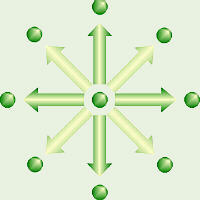

Ecology is the study of the relationship between organisms and their environment. Ecology includes or is a blending of a number of disciplines and philosophies, which are not always in agreement with each other, including physiology, genetics, chemistry, physics, climatology, geology, geography, sociology, economics, and evolution and speciation. Ecology includes the study of populations, communities, ecosystems, and the biosphere.
The modern study of biology began with naturalists like Linnaeus and Darwin who observed the world around them and recorded what they saw. For many years, biology had an “image problem” and was often criticized by chemists and physicists who felt biology was not a real science because it was not quantitative. In reaction to this, by the 1950 to 60s, the emphasis of much biological research had switched more to molecular biology (which because it was more quantitative, was thought of as being more “legitimate” or “glamorous”) as biologists tried to quantify their data and prove that biology was really science. The environmental movement which began in the late-’60s to early-’70s brought ecology (or at least a close misunderstanding thereof) to everyone’s attention. While as a result of that movement, the study of ecology has gained “respectability” within the scientific and lay communities, the major biological research emphasis these days is in genetics and DNA research, and funding for research on whole organisms and their ecological relationships is much harder to find.
The first people to notice a relationship between organisms and their environment were plant geographers, who studied the relationship between climate and the vegetation growing in an area. In 1866, Ernest Hackel, a German biologist, coined the term “oekologie” to mean the relationship of animals to their environment, including both the organic and inorganic components. Initially, plant and animal ecology each went their own ways, often ignoring or even disagreeing with each other. In 1914, Victor Shelford, who studied animal ecology, was the first person to stress the importance of the relationships between plants and animals and the idea of ecology as a study of communities of organisms. A. G. Tansley took Shelford’s ideas one step farther when he said that plants and animals are components of a system that also includes physical factors that affect or shape the system. He was the first person to use the term ecosystem to describe the totality of these species, factors, and their interactions. In 1949, the book Principles of Animal Ecology by Allee, Emerson, Park, Park and Schmidt, (the “Chicago Five”) emphasized and defined directions for much of modern ecology, including a formal definition of ecology as the science of the interrelations between living organisms and their environment, including both physical and biotic factors, as well as intraspecific and interspecific interactions. Victor Shelford and F. E. Clements introduced the idea of biomes, which they defined as major regional biotic communities of plants and animals together. The eastern deciduous forest, the prairie of the Great Plains, or the southwestern desert would be examples of biomes.
Ecology may be divided into two broad approaches. Some ecologists prefer to look at individual organisms (or species) and how those individuals influence or are influenced by their environment (autecology). Other researchers prefer to consider all of the interactions and exchanges within a given ecosystem (synecology). For this course, we will be using each of these approaches at times, depending on the topic under discussion.
| Autecology | Synecology |
|---|---|
 |
 |